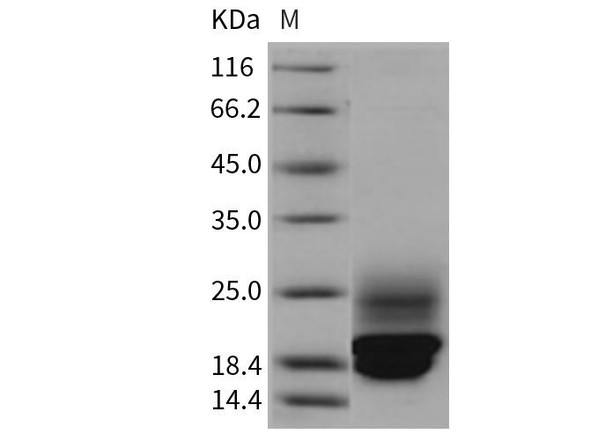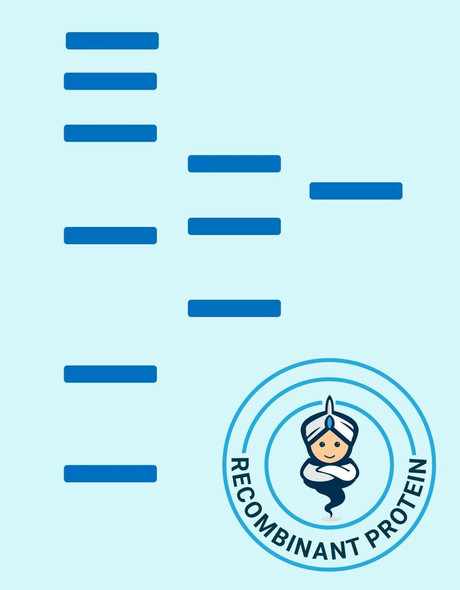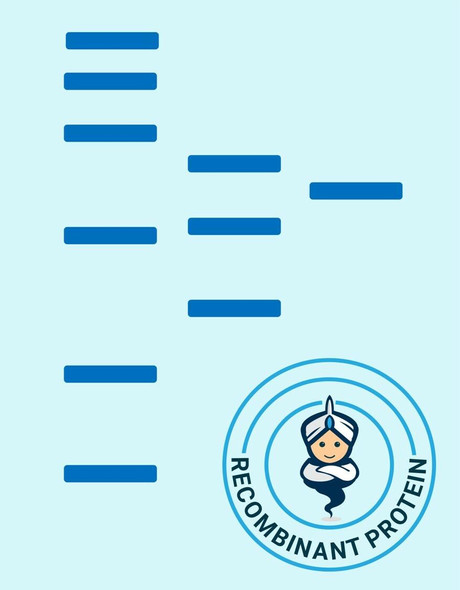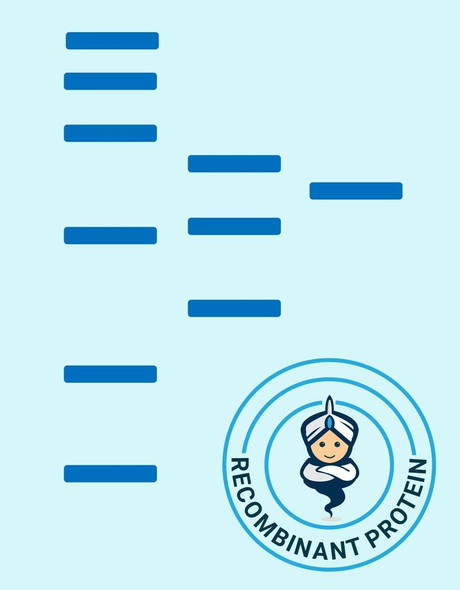Description
| Product Name: | Rat CST3 Recombinant Protein |
| Product Code: | RPPB3286 |
| Size: | 10µg |
| Species: | Rat |
| Target: | CST3 |
| Synonyms: | Cystatin-C, Cystatin-3, CYSC, MGC105556. |
| Source: | Escherichia Coli |
| Physical Appearance: | Sterile Filtered White lyophilized (freeze-dried) powder. |
| Formulation: | Filtered (0.4 micron) and lyophilized from 0.5 mg/ml in 0.03M Acetate buffer, pH 4. |
| Solubility: | Add 0.2 ml of 0.1M Acetate buffer pH4 and let the lyophilized pellet dissolve completely. For conversion into higher pH value, we recommend intensive dilution by relevant buffer to a concentration of 0.1mg/ml. In higher concentrations the solubility of this antigen is limited. |
| Stability: | Store lyophilized protein at -20°C. Aliquot the product after reconstitution to avoid repeated freezing/ thawing cycles. Reconstituted protein can be stored at 4°C for a limited period of time; it does not show any change after two weeks at 4°C. |
| Purity: | Greater than 96% as determined by SDS-PAGE. |
| Amino Acid Sequence: | MRGSHHHHHH GMASGTSRPP PRLLGAPQEA DASEEGVQRA LDFAVSEYNK GSNDAYHSRA IQVVRARKQLVAGINYYLDV EMGRTTCTKS QTNLTNCPFH DQPHLMRKAL CSFQIYSVPW KGTHTLTKSS |
Cystatins are a superfamily of cysteine proteinase inhibitors found in both plants and animals. They comprise a group of proteinase inhibitors, widely distributed in tissues and body fluids, and form tight complexes with cysteine proteases such as cathepsin B, H, L and S. Cystatin C, a secreted molecule of this family, is of interest from biochemical, medicine and evolutionary points of view. Cystatin C, with molecular weight of 13260 Da, is composed of 120 amino acids, lacks carbohydrate and has two disulfide bridges located near the carboxyl terminus. Cystatin C is increased in patients with malignant diseases, and is related to the insufficiency of renal function and appears to be a better marker than creatinine. On the other hand, low levels of cystatin C involve cause the breakdown of the elastic laminae and, subsequently, the atherosclerosis and abdominal aortic aneurysm.
Total 134 AA, Mw: 14.93 kDa (calculated). N-terminal His-tag (14AA).
| UniProt Protein Function: | CST3: As an inhibitor of cysteine proteinases, this protein is thought to serve an important physiological role as a local regulator of this enzyme activity. Defects in CST3 are the cause of amyloidosis type 6 (AMYL6); also known as hereditary cerebral hemorrhage with amyloidosis (HCHWA), cerebral amyloid angiopathy (CAA) or cerebroarterial amyloidosis Icelandic type. AMYL6 is a hereditary generalized amyloidosis due to cystatin C amyloid deposition. Cystatin C amyloid accumulates in the walls of arteries, arterioles, and sometimes capillaries and veins of the brain, and in various organs including lymphoid tissue, spleen, salivary glands, and seminal vesicles. Amyloid deposition in the cerebral vessels results in cerebral amyloid angiopathy, cerebral hemorrhage and premature stroke. Cystatin C levels in the cerebrospinal fluid are abnormally low. Genetic variations in CST3 are associated with age- related macular degeneration type 11 (ARMD11). ARMD is a multifactorial eye disease and the most common cause of irreversible vision loss in the developed world. In most patients, the disease is manifest as ophthalmoscopically visible yellowish accumulations of protein and lipid that lie beneath the retinal pigment epithelium and within an elastin-containing structure known as Bruch membrane. Belongs to the cystatin family. |
| UniProt Protein Details: | Protein type:Secreted; Inhibitor; Secreted, signal peptide Cellular Component: extracellular space; nuclear membrane; contractile fiber; endoplasmic reticulum; lysosome; extracellular region; multivesicular body; cell projection; cell soma; axon; perinuclear region of cytoplasm; cytoplasm; basement membrane; vesicle Molecular Function:protease binding; protease inhibitor activity; beta-amyloid binding; endopeptidase inhibitor activity; cysteine protease inhibitor activity Biological Process: salivary gland development; apoptosis; response to toxin; negative regulation of peptidase activity; defense response; response to organic cyclic substance; response to carbohydrate stimulus; response to estradiol stimulus; positive regulation of cell proliferation; fibril organization and biogenesis; circadian sleep/wake cycle, REM sleep; response to axon injury; response to nutrient levels; negative regulation of proteolysis; response to drug; response to inorganic substance; male gonad development; regulation of programmed cell death; Sertoli cell development; cell activation; eye development; response to hypoxia; brain development; response to oxidative stress; positive regulation of DNA replication; embryo implantation; regulation of tissue remodeling |
| NCBI Summary: | extracellular cysteine protease inhibitor that may be involved in amyloidosis [RGD, Feb 2006] |
| UniProt Code: | P14841 |
| NCBI GenInfo Identifier: | 83301921 |
| NCBI Gene ID: | 25307 |
| NCBI Accession: | P14841.2 |
| UniProt Secondary Accession: | P14841,Q5M968, |
| UniProt Related Accession: | P14841 |
| Molecular Weight: | 15,437 Da |
| NCBI Full Name: | Cystatin-C |
| NCBI Synonym Full Names: | cystatin C |
| NCBI Official Symbol: | Cst3�� |
| NCBI Official Synonym Symbols: | CYSC�� |
| NCBI Protein Information: | cystatin-C; cystatin 3; cystatin-3; Cystatin C (cysteine proteinase inhibitor) |
| UniProt Protein Name: | Cystatin-C |
| UniProt Synonym Protein Names: | Cystatin-3 |
| Protein Family: | Cystatin |
| UniProt Gene Name: | Cst3�� |
| UniProt Entry Name: | CYTC_RAT |






